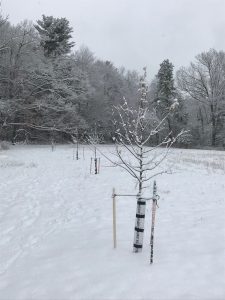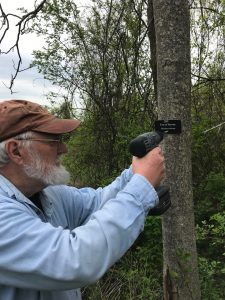Holcomb Tree Trail Planting & Design

How are the Trees Planted?
Volunteers locate appropriate sites for each tree to be planted. In late spring, existing vegetation at each planting site is weed-whacked to bare ground. Then each hole, generally 42 inches in diameter and eight to 10 inches deep, is excavated, any rocks and roots are removed, and then the soil is placed back in the hole. The hole is then covered with pine bark mulch, about four to six inches deep.
In the fall, when the trees arrive on site, the mulch and soil are removed and put in separate piles to the side. The root mass is placed in the shallow hole and as the soil is gradually returned, it is watered to avoid air pockets. The root flare is left exposed above ground. Usually, 10 to 15 gallons of water per hole are required. The mulch is re-spread at a three-inch depth, with a few inches of bare ground left around the trunk. The trees are staked (the site is sometimes windy) and half-inch hardware cloth is wrapped very loosely around the trunk, up to three feet (or below the lowest branch if shorter). This is to protect against buck rub by deer and chewing on bark by small mammals. Damage from either can kill or weaken a tree.
The Holcomb Tree Trail plants trees that are grown at a nursery using the Missouri Gravel Bed Method, which results in a very thick mass of bare roots. With this method, trees are planted in 18 inches of pea stone irrigated with water to which nutrients have been added. When the tree is removed from the bed and the gravel is shaken off, an 8- or 10-foot tree and 1.5-inch caliper, can be picked up easily by an average person with one hand. Planting bare root trees grown by this method allows all the planting work to done without machinery.
We Follow Five Design Principles:
- Preserve the long views of surrounding hills
- Encourage agricultural use
- Manage invasives by mowing and mechanical removal—no chemicals are used to remove plants
- Plant both native and non-native trees, emphasizing spring bloom and fall color
- Encourage bird habitat by planting trees that attract birds.


Who Does the Work?
Volunteers from the Granby community plant all the trees. So far, about ten volunteers have committed to these efforts. These volunteers also water the trees using five gallon buckets. Volunteers also do weed removal around planting sites. Planting is organized by Friends of Holcomb Farm Stewardship Committee. Invasive plants (most common are bittersweet, multiflora rose and Japanese barberry) are removed from the hedgerows around the fields, and from around eastern red cedar trees by volunteer work parties organized and scheduled by Friends of Holcomb Farm Stewardship Committee.

